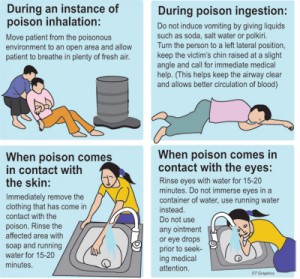Beware of the lurking threats in your home
There are little considered dangers lurking in all our homes. We’re talking of household chemicals that make our daily lives easier but which can also cause harm. According to the National Poisons Information Centre, there is a sharp rise in the number of reported cases of household poisoning.
 “This is the new trend that we’ve observed and mosquito coils and sprays are No. 1 on the list of culprits,” says Dr. Waruna Gunathilake, Head of the Toxicology & National Poisons Information Centre, pointing out that there have been 377 cases of household poisoning in 2014 while there were only 62 cases in 2013.
“This is the new trend that we’ve observed and mosquito coils and sprays are No. 1 on the list of culprits,” says Dr. Waruna Gunathilake, Head of the Toxicology & National Poisons Information Centre, pointing out that there have been 377 cases of household poisoning in 2014 while there were only 62 cases in 2013.
There have been 66 cases of household poisoning caused by mosquito coils and sprays (pyrethroid), followed by toilet cleaner with 42 cases and rat-killers (rodenticide) with 40 cases. Glue comes in next with 25 cases and washing powder with 21 cases.
In fact, this year’s National Poison Prevention Week from September 14-20 will be on the theme “Preventing Household Poisoning”.
“While there is a decrease in the number of plant poisoning cases, the rapid rise of household poisoning cases is alarming and many of the victims are children under the age of three years,” says Dr. Gunathilake, adding that the upcoming National Poison Prevention Week will focus awareness on how to prevent this issue.

Dr. Waruna Gunathilake
A glance at the chemicals used in the manufacture of mosquito repellents, reveals active ingredients known as pyrethrins, that are extracted from chrysanthemums. In the absence of light, pyrethrins break down very slowly and have half-lives of up to 14 or 17 days. Pyrethrins that come in contact with water do not dissolve well and tend to bind to sediment.
Dr. Gunathilake states that pyrethrins have the long term effect of increasing the risk of lung cancer, chronic obstructive pulmonary disease (COPD), chemical pneumonia and muscle twitching.
Safety tips
- Avoid spraying repellents in areas where children are present
- Do not use mosquito repellents in closed rooms at night
- Pregnant and nursing women should minimize use of repellents
- Do not use repellent if a person can’t tolerate the smell, or starts coughing
- When using pyrethroid treated mosquito nets, keep it out for 1-2 days in order to dilute the concentration.
First Aid
- If the repellent gets in the eyes flush out with cold running water immediately
- If the repellent is ingested, wash mouth immediately and take patient to the nearest hospital along with the container
When it comes to washing powder there are two main types to be identified, says Dr. Gunathilake.
“The white coloured powder contains oxalic acid, which is corrosive to the gastrointestinal tract and ingestion will lead to severe blood loss and shock. The dark coloured powder contains potassium permanganate and can lead to nausea, vomiting, abdominal pain and even methhaemoglobinaemia.”
“We have seen that most companies do not mention all the chemicals present in the washing powder on their labels. This is a serious issue,” laments Dr. Gunathilake. He points out that this leads to the inability to treat for the right type of poisoning and thus standards must be in place for strict regulation of labelling.
Safety tips
- Store the detergents away securely in a safety locker
- Make the packets less colourful and less attractive to children
First Aid
If ingested:
- Do not induce vomiting
- Do not give anything to drink
Another worrying trend seen by the team at the Poisons Information Centre is the number of patients admitted with kerosene poisoning. “It’s very important that people avoid inducing vomiting as it can get aspirated into the lung causing pneumonia,” says Dr. Gunathilake, pointing out that this causes patients to eventually die of pneumonia, whereas the poisoning could have been treated completely by hospital staff.
Kerosene poisoning has ocular and dermal effects with erythema and superficial burns being common.
Safety tips
- Store kerosene bottles in a locked cupboard
- Do not keep kerosene bottles at the ground level
- Never leave containers open when not in use.
First Aid
- Remove patient from exposure
- Wash the contaminated area thoroughly
- Do not induce vomiting
- Maintain a clear airway and adequate ventilation
Another warning which comes from Dr. Gunathilake is that the centre has found that many people are buying unregistered rat-poison and no one seems to know where these are produced. “We’ve received several reports from the Western province of unregistered rat-poison and it is a matter that needs to be immediately looked into,” he stresses.


